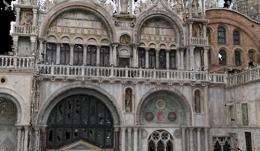Geo-immersion makes maps come alive

When it comes to mapping the real world on computers, University of Southern California computer scientist Cyrus Shahabi takes his work to a whole new dimension.
Upon first glance, his maps contain the typical landmarks we've become accustomed to seeing on Yahoo or Google Maps. If you look a little closer, you'll see the maps are also pulsing with images of moving cars and scenes of bustling people, all in real time. It is part of a new computing concept called "Geo-Immersion" that blends the real and virtual worlds together.
"The idea was to capture a real world environment and then render it virtually so it feels like you are in that area. So you are immersed in that geographical area as if you are in the real world," says Shahabi who also serves as the director of USC's Integrated Media Systems Center, a graduated NSF Engineering Research Center (ERC). Support from the National Science Foundation (NSF) has kept the center at the forefront of multimedia and Internet technology. Shahabi says what makes Geo-Immersion unique is its capability to mesh existing information databases and social networks, and integrate them with maps. Geo-Immersion is the foundation of several applications Shahabi has in the works.
One of them is called the "clever transportation" project. It takes a Google map of Los Angeles and adds a few colorful characteristics. Roads that are clogged with slower moving traffic are colored red and roads where traffic is moving faster are colored green.
"These historical patterns are created based on real-time data that we collect," says Shahabi, looking at a full-screen map of LA County. "[It] shows how the trend of traffic changes over the course of time." Depending on the time of day, Shahabi says, the program changes the "fastest path" because it takes traffic into consideration, a trick that Google Maps doesn't have.
Shahabi is also working on another prototype application called iCampus. It gives users on the USC campus real-time locations of their Facebook and Twitter friends as well as a look at building floor plans and energy usage inside campus buildings.
iCampus has numerous applications including "tram tracking." Shahabi says USC trams are outfitted with a GPS unit that transmits a signal every five seconds. "One of my undergrad students built an iPad application on top of iCampus where, from your house, you can check what time the bus gets to the closest stop," says Shahabi. The application, iCampus, has the capabilities to be tailored to other campuses or even small cities.
Another application through Geo-Immersion, called iWatch, could also benefit law enforcement as an enhanced surveillance tool. It includes facial detection ability that can follow a person from location to location.
All of the Geo-Immersion applications are bringing the virtual and actual world a little closer together.
Provided by National Science Foundation




















